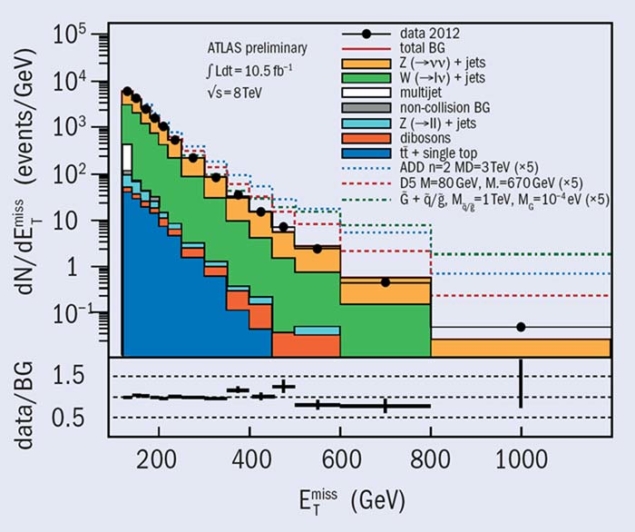Events with a single jet of particles in the final state have traditionally been studied in the context of searches for supersymmetry, for large extra spatial dimensions and for candidates for dark matter. Having searched for new phenomena in monojet final states in the 2011 data, the ATLAS collaboration turned its attention to data collected in 2012, with the first results presented at the Hadron Collider Physics (HCP) symposium in Kyoto in November.

Models with large extra spatial dimensions aim to provide a solution to the mass-hierarchy problem (related to the large difference between the electroweak unification scale at around 102 GeV and the Planck scale around 1019 GeV) by postulating the presence of n extra dimensions, such that the Planck scale in 4+n dimensions becomes naturally close to the electroweak scale. In these models, gravitons (the particles hypothesized as mediators of the gravitational interaction) are produced in association with a jet of hadrons; the extremely weakly interacting gravitons would escape detection, leading to a monojet signature in the final state.

Dark-matter particles could also give rise to monojet events. According to the current understanding of cosmology, non-baryonic non-luminous matter contributes about 23% of the total mass-energy budget of the universe but the exact nature of this dark matter remains unknown. A commonly accepted hypothesis is that it consists of weakly interacting massive particles (WIMPs) acting through gravitational or weak interactions. At the LHC, WIMPs could be produced in pairs that would pass through the experimental devices undetected. Such events could be identified by the presence of an energetic jet from initial-state radiation, leading again to a monojet signature. The LHC experiments have a unique sensitivity for dark-matter candidates with masses below 4 GeV and are therefore complementary to other searches for dark matter.
The study presented at HCP uses 10 fb–1 of proton–proton data collected during 2012, at a centre-of-mass energy of 8 TeV. As with the earlier analysis, the results are still in good agreement with the predictions of the Standard Model (figure 2). The new results have been translated into updated exclusion limits on the presence of large extra spatial dimensions and the production of WIMPs, as well as new limits on the production of gravitinos (the supersymmetric partners of gravitons) that result in the best lower bound to date on the mass of the gravitino.
Further reading
ATLAS collaboration, ATLAS-CONF-2012-147 (and references therein).





